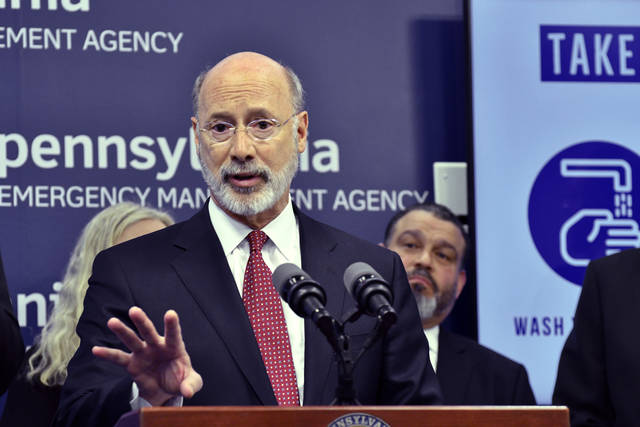What moving into 'green' zone does, does not mean under Gov. Wolf's reopening plan
Gov. Tom Wolf offered a glimpse Friday afternoon of what moving into the “green” zone of Pennsylvania’s reopening plan will and will not mean, as 17 counties prepare to reopen businesses at the end of next week.
“I must emphasize that moving into the green phase will still require precautions to keep our communities and our families safe,” Wolf said during a virtual news conference. “Covid-19 continues to be a threat … and, unfortunately, that won’t change until we have a vaccine or a cure.”
With the exception of Lawrence County, which will move into the green phase, Western Pennsylvania remains in the “yellow” cautionary phase — during which many businesses reopened but restaurants, bars, salons, gyms, entertainment venues and other facilities have remained closed to in-person service.
The green zone — which Wolf described as a step “near normalcy” — still will mandate pandemic-spurred restrictions to thwart the spread of covid-19.
Limits on large events remain
Going green still includes restrictions on visitation at nursing homes, which have been hit hard by covid-19 deaths, Wolf said.
“And hospitals and prisons may have visitation restricted on a case-by-case basis as necessary,” Wolf said.
Most businesses can resume, albeit while abiding by social distancing rules set by the Centers for Disease Control and Prevention. Such guidance includes wearing masks in public, keeping at least six feet away from others outside of family members and staying home when feeling sick.
Many retailers — such as restaurants and bars — still will have reduced capacity and occupancy limits, as will the likes of elevators, escalators and Downtown Pittsburgh high-rises.
Don’t expect to see any festivals, sporting events or concerts resume anytime soon — likely not until a safe and effective vaccine becomes available, according to Wolf. The statement is in line with prior remarks by Dr. Anthony Fauci of the White House Coronavirus Task Force.
Even in the green phase, Wolf encourages that workers who can telecommute continue to do so.
The goal of the governor’s color-coded plan to reopen the state gradually is to “provide the greatest freedom while preventing certain situations that are known to be catalysts for the transmisison of covid-19,” Wolf said.
Fitzgerald hopes Allegheny County will ‘go green’ next week
Wolf did not yet set a date for moving Allegheny, Westmoreland, Butler, Armstrong, Washington, Fayette and Greene counties into the green phase. He mentioned that local officials in some places, such as Centre County, have asked him not to expedite their county’s move to green.
Allegheny County Executive Rich Fitzgerald is hopeful his county could transition to the green phase by the end of the month.
“We and our neighbors around us have been in the yellow in a week. Thus far, our numbers have remained relatively low. And that’s a good thing,” Fitzgerald told the Tribune-Review by phone Friday evening. “If we continue that for another week, if our numbers continue to stay low … I’m optimistic that we could get sent into the green phase in another week.”
RELATED: Allegheny County adds 2 coronavirus deaths, 21 new cases
Fitzgerald noted that at least two counties that were among the state’s first cohort to move to the yellow phase — Erie and Mercer — will not be joining the first group going green.
Beaver County, where more than 70 have died of covid-19 at Brighton Rehabilitation and Wellness nursing home, moved to the yellow phase Friday morning. Most of Western Pennsylvania did so on May 15.
Forty-nine of the state’s 67 counties have moved into the yellow phase, with Philadelphia and all others that are still in the red zone set to transition to yellow phase by June 5.
“We have been closely monitoring these yellow counties for signs of outbreaks,” Wolf said. “We’ve had a few incidents that have caused some concern, but overall, we’ve seen most areas continue to maintain or reduce the covid-19 new case count. … We have sustained this decline even as we are reopening businesses and resuming activities, and our ability to detect and isolate new cases continues to improve with each passing day.”
Among metrics cited by Wolf as positive signs:
• The state’s covid-19 new case rate shrank by more than 50% from May 8 to May 15, and declined by another 30% the following week, from May 15 through Thursday;
• The number of patients hospitalized requiring ventilators have dropped from 505 people as of May 8 to 347.
• Testing capacity has increased from about 7,700 a day as of May 8 to more than 13,000 a day. More than 300 testing locations are available statewide “in almost every county,” Wolf said.
The coronavirus disease has killed nearly 5,000 people across the state, including 115 new deaths reported Friday, and more than 66,000 residents have contracted covid-19 since the first positive cases were diagnosed March 6.
Earlier in the day, the Wolf administration released guidelines for summer camps and other programs for children.
Wolf said he and his team will continue to work on increasing testing and developing a “roadmap” on how “to cope with a full resurgence, if one occurs.”
“This will allow every Pennsylvanian in our commonwealth to resume a more normal life without constant fear of contracting covid-19,” Wolf said.
RELATED: 115 new coronavirus deaths reported in Pennsylvania
Remove the ads from your TribLIVE reading experience but still support the journalists who create the content with TribLIVE Ad-Free.

